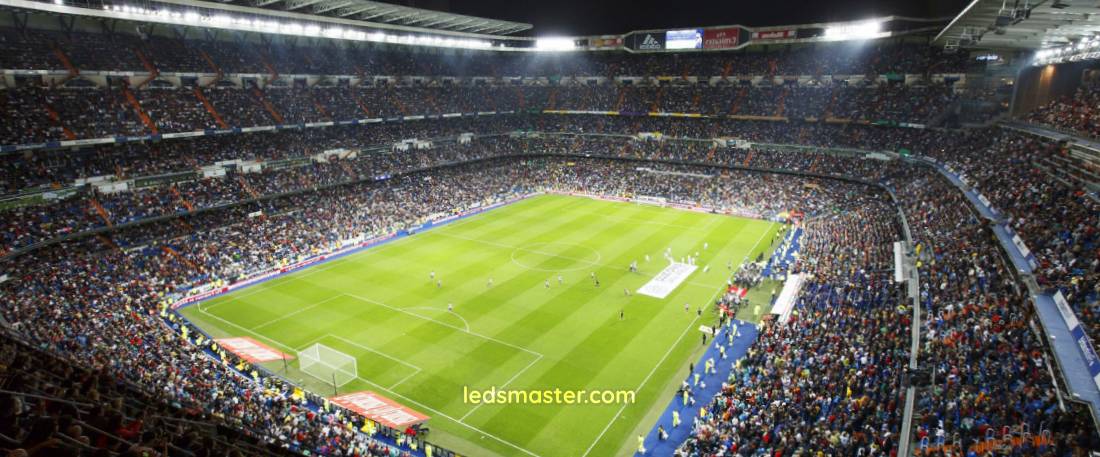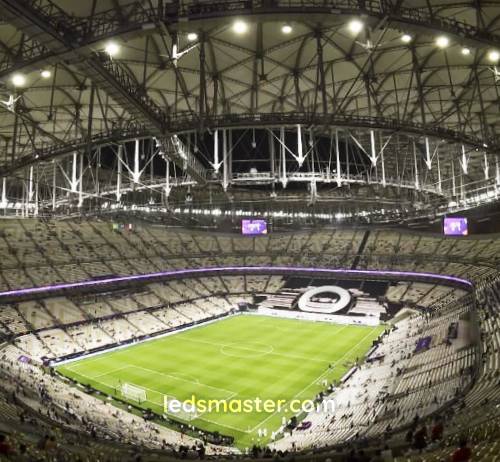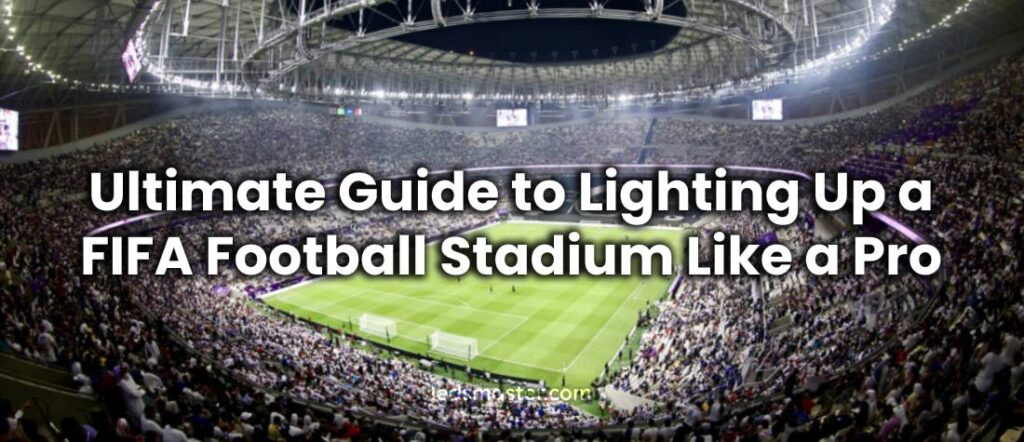Stadium lighting must meet FIFA’s stringent requirements, including specific lux levels, uniformity, color temperature, and glare control. The process involves selecting the right lighting system, calculating costs, and overcoming various challenges to achieve a professional setup.
Table of Contents
ToggleLux Requirements for FIFA Stadium Lighting
Stadium lighting plays a critical role in ensuring optimal visibility for players, referees, spectators, and television broadcasts. The brightness of a stadium is measured in lux, which represents the amount of light per square meter. FIFA has established specific lux requirements based on different levels of play, training sessions, and broadcast standards to ensure consistent lighting quality across various competitions.
For standard training sessions and amateur matches, the required illumination is around 500 lux, which provides adequate brightness for players and coaches while minimizing energy consumption. This level is suitable for local leagues, recreational games, and non-televised events where high-definition visibility is not a primary concern.
For professional national and international matches, especially those broadcasted in high definition (HD), FIFA mandates a minimum illumination level of 2000 lux. This ensures that every corner of the field is well-lit, allowing players to react quickly and referees to make accurate calls. The increased brightness is also essential for audience experience, as it enhances visibility for spectators in large stadiums.

For FIFA World Cup matches or international broadcasts in ultra-high-definition (UHD) and 4K/8K resolution, lighting requirements increase further. In these cases, FIFA recommends lux levels exceeding 2500 lux to support the advanced cameras used in modern broadcasting. Higher lux levels improve image clarity, reduce motion blur, and enhance color contrast, making televised games more immersive for viewers worldwide.
Beyond just brightness, horizontal and vertical illuminance must be carefully balanced to prevent shadows and uneven lighting. Horizontal illuminance refers to the brightness across the playing field, while vertical illuminance—which is crucial for television cameras—focuses on lighting the players’ faces and bodies. FIFA guidelines recommend a vertical illuminance of 800 to 1000 lux to ensure players remain clearly visible from all camera angles, eliminating dark spots that could disrupt the viewing experience.
| Lighting Component | Details | Lux Requirements |
|---|---|---|
| Standard Training & Amateur Matches | Adequate illumination for local leagues and non-televised events | 500 lux |
| Professional National & International Matches | For HD broadcast and player visibility | 2000 lux |
| FIFA World Cup & UHD Broadcast | For 4K/8K broadcast, reducing motion blur and enhancing clarity | >2500 lux |
| Vertical Illuminance | Ensures player visibility from all camera angles | 800 – 1000 lux |
| Color Temperature | Recommended for player comfort and clarity in broadcast | 4000K – 6000K |
| Optimal LED Color Temperature | Ideal for natural daylight balance and improved contrast | 5000K – 5700K |
| Color Rendering Index (CRI) | Ensures accurate color reproduction for international events | >80 (Professional stadiums aim for 90+) |
| Uniformity Ratio (U1) for General Matches | Minimum ratio for lower-tier competitions | 0.5 |
Color Temperature for Stadium Floodlights
The color temperature of stadium lighting is another critical factor affecting visibility, player comfort, and broadcast quality. Measured in Kelvin (K), color temperature determines the color appearance of the light, ranging from warm yellowish tones to cool daylight-like hues.
FIFA recommends a color temperature between 4000K and 6000K, which falls within the natural white to cool daylight spectrum. This range ensures that lighting remains comfortable for players while enhancing contrast and clarity for spectators and broadcasters.
Most modern stadiums choose LED floodlights with a color temperature between 5000K and 5700K, as this range offers an ideal balance between natural and bright daylight effects. This temperature enhances color contrast, making it easier for players to track the ball and helping referees make accurate decisions. It also improves visibility for spectators, creating a clear and immersive stadium experience. Additionally, for television broadcasts, particularly in high-definition and ultra-high-definition formats, this lighting ensures accurate color reproduction and eliminates unnatural tints, resulting in a more visually appealing and realistic viewing experience.
Another crucial aspect is the Color Rendering Index (CRI), which measures how accurately colors appear under artificial lighting. FIFA requires a CRI above 80, but professional stadiums often aim for CRI 90+, especially for international events where maintaining color accuracy is essential for high-quality TV broadcasts. A high CRI ensures that team uniforms, the pitch, and the ball appear natural and vivid on screen, preventing washed-out or overly saturated visuals.

Light Uniformity in Football Stadiums
Achieving uniform lighting across the entire playing field is just as important as brightness. Poor uniformity results in harsh shadows, dark patches, and overly bright areas, which can affect player performance and viewer experience.
The uniformity ratio (U1) is the standard measurement used to assess lighting consistency. It is calculated by comparing the lowest-lit areas of the field to the brightest areas.
For general matches and lower-tier competitions, the uniformity ratio should be at least 0.5, meaning that the dimmest parts of the field receive at least 50% of the illumination of the brightest spots. For FIFA-level international matches, the uniformity requirement is more stringent, with a minimum ratio of 0.7. This ensures that lighting is evenly distributed, eliminating potential vision problems for players and ensuring a balanced field appearance for broadcasters.
To meet uniformity standards, advanced stadium lighting designs rely on precise floodlight placement to ensure even light distribution across the field. Beam angles are carefully calculated to minimize overlapping shadows and eliminate excessively bright areas that could cause glare or discomfort. Optical lenses and reflectors are also utilized to direct and diffuse light where necessary, creating a seamless balance of brightness across the playing surface.
Modern stadiums further enhance lighting consistency by incorporating dynamic lighting controls. These systems allow operators to adjust brightness levels based on match requirements, weather conditions, and specific event needs. In addition to improving uniformity, smart lighting technology helps optimize energy consumption by preventing unnecessary over-illumination, making stadium operations more efficient and cost-effective.
Challenges in Stadium Lighting Installation
Installing a FIFA-compliant stadium lighting system involves a range of technical, environmental, and logistical challenges. From ensuring proper brightness levels to minimizing light pollution and addressing long-term maintenance needs, stadium operators must carefully plan every aspect of the lighting setup to guarantee optimal performance.
Achieving FIFA Compliance
Meeting FIFA regulations for stadium lighting is a complex task that requires meticulous planning and precise execution. FIFA standards dictate specific lux levels, uniformity, and glare control to ensure players, referees, and spectators experience consistent visibility. Additionally, broadcast requirements for high-definition and ultra-high-definition television coverage necessitate advanced lighting designs that eliminate flickering and shadows.
To comply with these strict standards, stadiums must invest in high-quality LED floodlights designed for professional sports applications. These fixtures must be strategically positioned at calculated angles to achieve uniform illumination across the field without causing excessive glare or hot spots. Striking a balance between brightness, uniformity, and energy efficiency while maintaining compliance with FIFA’s guidelines remains a significant challenge for lighting engineers and stadium operators.
Minimizing Light Pollution
One of the primary concerns when installing stadium lighting is the impact on the surrounding environment. Large sports venues emit intense light that can spill into nearby residential or commercial areas, causing light pollution and disrupting communities. Without proper shielding and directional optics, excess light can also contribute to skyglow, reducing visibility of the night sky and affecting local ecosystems.
To mitigate these issues, modern stadium lighting systems incorporate advanced anti-glare optics, precision-angled floodlights, and specialized shielding to direct illumination onto the field while minimizing unwanted light spillage. Additionally, smart lighting control systems allow operators to adjust brightness levels based on real-time requirements, further reducing unnecessary light emissions and ensuring compliance with environmental regulations.
Power Supply and Energy Consumption
Stadium lighting requires a massive amount of electrical power, presenting a significant challenge in terms of infrastructure and ongoing energy costs. Traditional metal halide lamps consumed substantial energy, leading to high operational expenses and the need for powerful electrical grids to sustain lighting during matches.
With the shift to LED floodlights, energy consumption has decreased significantly, but stadiums still require robust electrical systems, including high-capacity transformers, backup generators, and surge protection mechanisms. Ensuring a stable power supply is critical, particularly for televised events where even a brief blackout can result in substantial financial losses and damage to the stadium’s reputation.
Energy efficiency remains a key concern, as operators seek to minimize electricity usage while maintaining FIFA-required brightness levels. Many modern stadiums now integrate renewable energy sources such as solar panels and energy storage solutions to supplement power needs and reduce reliance on traditional electrical grids.
Weather and Environmental Factors
Outdoor stadiums are exposed to extreme weather conditions, which can pose significant challenges to lighting installations. Floodlights must be designed to withstand harsh elements such as heavy rainfall, strong winds, snow, and extreme temperature fluctuations. Without proper weather resistance, lighting fixtures can degrade over time, leading to performance issues and increased maintenance costs.
To ensure longevity, LED stadium floodlights are manufactured with high Ingress Protection (IP) ratings—typically IP65 or higher—making them resistant to water, dust, and other environmental factors. Additionally, durable mounting structures must be engineered to endure strong wind loads and potential impacts, ensuring the lighting system remains stable and operational in all weather conditions.
Extreme temperatures also affect lighting performance, as excessive heat can reduce the efficiency and lifespan of LED components. Advanced cooling systems, including heat sinks and active ventilation, are often incorporated into high-power LED fixtures to maintain optimal operating conditions and prevent overheating.
Maintenance and Longevity
One of the biggest advantages of LED stadium lighting over traditional metal halide lamps is its significantly longer lifespan and lower maintenance requirements. While metal halide lights required frequent replacements and had long warm-up times, modern LED floodlights offer lifespans ranging from 50,000 to 100,000 hours, dramatically reducing maintenance efforts and costs.
However, even LED floodlights require periodic upkeep to ensure peak performance. Dust, dirt, and debris can accumulate on fixtures, reducing brightness and altering light distribution. Regular cleaning schedules, along with routine inspections of electrical connections, mounting brackets, and control systems, are essential to maintaining consistent lighting quality.
Moreover, advancements in smart lighting technology now allow stadium operators to monitor system performance in real time, detecting potential failures before they occur. Predictive maintenance systems, integrated with IoT-based monitoring, help prevent unexpected breakdowns and extend the operational lifespan of stadium lighting installations.
Estimated Cost of FIFA-Standard Stadium Lighting
Building a FIFA-standard stadium lighting system is a significant investment, involving multiple cost factors such as LED floodlights, installation, power consumption, and long-term operational expenses. These components contribute to the overall price, which can range from several hundred thousand to a few million dollars, depending on the size of the stadium and the specific lighting requirements.
| Component | Details | Cost Range |
|---|---|---|
| LED Floodlights (2000W each) | Price per unit for a 2000W LED floodlight | $1,500 – $3,000 per unit |
| Total Cost of Floodlights | For 200 to 400 floodlights in a FIFA-standard stadium | $300,000 – $1,200,000 |
| Installation Costs | Labor, wiring, poles, control systems, and safety measures | $100,000 – $500,000 |
| Power Consumption (Per Hour) | Energy consumption of a 2000W LED floodlight | 2 kWh per hour |
| Total Energy Consumption (300 lights) | Total energy consumption per hour | 600 kWh |
| Running Cost (Per Match) | Electricity cost for a 3-hour match | $216 |
| Season Running Cost (30 Matches) | Total electricity cost for a season of 30 matches | $6,500 – $7,000 |
| Total Investment (Complete System) | Total cost for LED floodlights, installation, and infrastructure | $500,000 – $2,000,000 |
Cost of LED Floodlights
 The most crucial component of stadium lighting is high-powered LED floodlights, which provide bright, uniform illumination to meet FIFA standards. The price of professional-grade LED floodlights varies based on factors such as wattage, brand, and optical quality. Typically, a 2000W LED floodlight—one of the most common types used in stadiums—costs between $1,500 and $3,000 per unit.
The most crucial component of stadium lighting is high-powered LED floodlights, which provide bright, uniform illumination to meet FIFA standards. The price of professional-grade LED floodlights varies based on factors such as wattage, brand, and optical quality. Typically, a 2000W LED floodlight—one of the most common types used in stadiums—costs between $1,500 and $3,000 per unit.
For a FIFA-standard football stadium, which requires anywhere from 200 to 400 floodlights to ensure adequate visibility and compliance with broadcasting requirements, the total cost for the lights alone can range between $300,000 and $1,200,000. Higher-end brands with advanced optics, enhanced durability, and smart control features can push costs even higher.
Installation Costs
Beyond purchasing the lights, professional installation is another significant expense. A proper stadium lighting system requires a carefully planned layout to ensure uniform brightness, minimal glare, and optimal performance. Installation involves several steps, including erecting poles or mounting fixtures on existing structures, extensive wiring, control system integration, and safety measures.
Labor and installation costs vary based on the project’s complexity, location, and required infrastructure. In general, professional installation expenses range from $100,000 to $500,000. Factors such as pole height, soil conditions (for foundation work), and advanced control system integration can influence the final cost.
Power Consumption and Running Costs
One of the primary benefits of LED floodlights is their energy efficiency compared to traditional metal halide lamps. A 2000W LED floodlight consumes approximately 2 kWh per hour, significantly reducing electricity usage while providing superior brightness.
For a stadium equipped with 300 floodlights, the total energy consumption per hour is around 600 kWh. With an average electricity cost of $0.12 per kWh, running the lights for a 3-hour match costs approximately $216. Over an entire season of 30 matches, the total electricity expense amounts to about $6,500 to $7,000.
In addition to energy costs, stadiums must also budget for operational expenses, including routine maintenance, occasional repairs, and updates to lighting control systems. While LED floodlights have a longer lifespan compared to traditional options, factors like weather exposure, accidental damage, and technological upgrades may require additional investments over time.
Total Investment for a FIFA-Approved Lighting System
When considering all factors—LED floodlights, installation, infrastructure, and operational expenses—the total investment required for a FIFA-compliant stadium lighting system can range from $500,000 to $2,000,000.
While the initial cost is substantial, the long-term savings from energy-efficient LED technology, lower maintenance needs, and improved performance make it a worthwhile investment. Many stadiums also explore additional revenue opportunities, such as hosting night-time events, concerts, and televised matches, to offset costs and maximize returns on their lighting system.
Conclusion
Lighting a FIFA-standard football stadium requires meticulous planning, high-quality LED floodlights, and adherence to specific lux, uniformity, and color temperature standards. The shift to LED technology has improved energy efficiency, reduced maintenance costs, and enhanced visibility for players and spectators. While the investment can be significant, a well-designed lighting system ensures compliance with FIFA regulations, optimal performance, and a world-class football experience.

